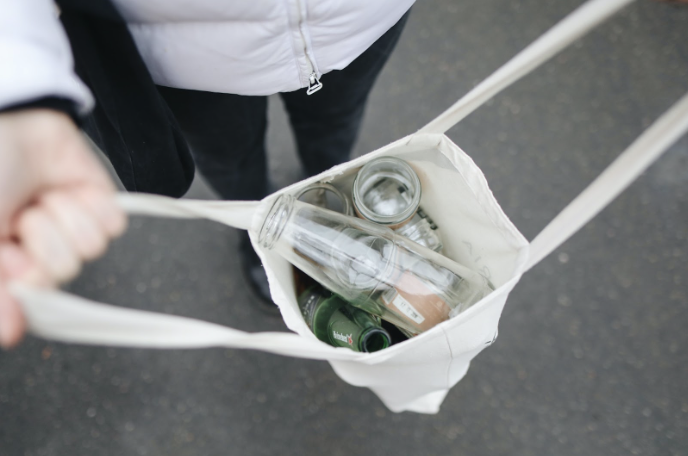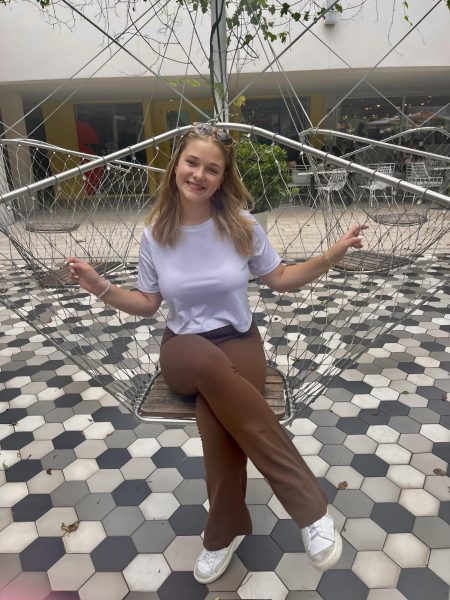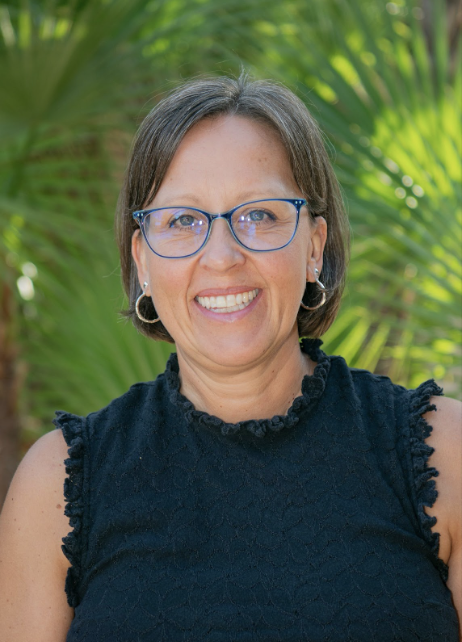8 Habits The Earth Will Thank You For
Sustainable habits you can start right now to keep our home planet green
January 31, 2023
With social media’s constant flow of zero-waste lifestyles and carbon-neutral lifestyles, it’s easy to get overwhelmed and feel like there’s nothing one person, particularly a teenager, can do to improve the situation; however, there are many small ways we can help. Here are eight of habits you can start right now that won’t change your life but will keep just one more piece of plastic out of our oceans and one percent of pollution out of the air.

bottles is just one of many ways to help the Earth. (Photo Credit: Pexels)
#8: Used before new. In today’s society, there is virtually no excuse for not checking for used items before buying new things. Consignment and second-hand stores are great places to start, but it doesn’t have to be that far from home. Before buying a new dress or pair of sneakers, check your closet to see if you have something similar. Experimenting with how different pieces of clothing fit together can be a fun activity, and most of the time can lead to an outfit never thought of before. There are also so many apps out there (Poshmark, Depop, etc.) that help you buy and sell clothing without ever having to step foot in a thrift store. Goodwill and other charitable places also often carry so much more than clothing—books, CDs, purses and jewelry. Also, if you’re looking to make some money, there are consignment stores that will pay for your used items, especially if you have grown out of the size or style of a piece. Think of it as a switch: when you sell or donate your clothes, it leaves more room for new pieces that someone else has given or sold, and your old things can go to someone new. Remember, something doesn’t have to be off the rack for it to be new for you; thrifting makes a great weekend activity with friends or by yourself.
#7: Check the impact. If you are unable to buy a used item, do a background check of the companies you’re buying from before you make your purchase. We all know the impact some companies have on the environment, but sometimes the worst ones can be hiding in plain sight. I love the app called Good on You, which easily tells you if the company is sustainable. If they’re not, the app provides sustainable alternatives with similar pieces and styles. The biggest thing to remember is that the most sustainable items available to you are the ones in your closet. Yes, it is better to buy from a thrift or slow fashion company than a fast fashion company, but if you’ve already purchased the piece, throwing it away makes the issue worse. Sometimes, fast fashion brands are the only ones available. But buying less and wearing more helps combat the negative effects of that item. Find new ways to wear the piece to make it last longer, or alter pieces by yourself or through a seamstress if they no longer fit you. When you’re done with the item, donate, sell or give it to someone else. Don’t ignore the impact of a brand just because it’s cheap or accessible in other ways. Save up for better quality and more sustainable items that last a lifetime.
#6: Be thoughtful about food. Just like clothing, only certain food companies treat their animals and employees with respect. Currently, there isn’t a food-wise parallel to Good on You, but I love Foodprint for general information about food sustainability; however, when a food company is certified to protect its workers, it will often have a Fair Trade Certification, and the food will have an icon on the packaging that tells you if the company has one. The biggest takeaways I’ve gotten from eco-friendly food research are to limit meat consumption, cook food at home and buy local. Limiting meat consumption is pretty self-explanatory, but it’s important also to consume enough protein to fill in the gaps in your diet. While meat, poultry, fish, eggs and dairy are packed with protein, there are many other plant-based foods, like veggies, fruits, nuts, beans, seeds and grains, that provide the same amount. And while cooking food at home can seem boring, using spices, experimenting with new recipes, and finding different ways to cook the same foods can be fun. If you listen to podcasts, audiobooks and music as much as I do, this is a perfect activity to do with your Airpods on full blast (not actually, though, protect your ears). So much food in our country goes to waste. In fact, Feeding America estimates that over 40% of the food in America ends up as food waste, which it defines as “safe, high-quality food that is thrown away rather than eaten.” And that the food that we waste could make about 130 billion meals, which could leave so many more people with food in their stomachs if that food wasn’t just thrown away. But how can we fix this? It starts small—by realizing that most of the food we throw away is perfectly edible. For example, broccoli and cauliflower stems can be cooked just like the florets. Watermelon rinds can be pickled and are a great source of citrulline, an amino acid that reduces blood pressure. The peels on oranges can be eaten just as they are, zested on baked goods, or candied for a sweet snack. And Aquafaba, the liquid that comes in chickpea containers, can be used for hundreds of things. Not everything has to be eaten—eggshells, for instance, can be used as a natural bandage, fertilizer or rinsed out to be a super healthy home for sproutlings.
#5: Composting. What should you do with all of the food you can’t use? Compost it! And don’t be fooled, composting has come a long way. It doesn’t have to be a huge wooden structure in your backyard full of worms. This one from Amazon is only 28 bucks and can sit on your kitchen table. Plus, it’s one of the cheapest and is highly celebrated options. It’s easy, cute enough and doesn’t stink. After you have your composting bin, there is virtually an endless amount of how-to’s out there, but a good overview with step-by-step instructions from Almanac will show you the basics.
#4: Explore other options. When you do buy something new, see if there are other eco options. A quick Google search can teach you about how many bamboo toothbrushes, silk floss, reusable cotton pads, beeswax wrap and sugarcane feminine products there are. Just being mindful of the plastic you’re using and the infinite other products you could be using is the first step to change. In modern society, most single-use items have other alternatives, and it just takes a moment of extra thought. Remember to grab reusable bags before heading to the grocery store, grab a washable plate instead of something single-use, bring a stainless water bottle to school and choose a reusable container instead of a plastic bag, etc. These changes have a direct impact—even if it’s just one thing, that’s one more piece of plastic that’s not in Tampa Bay.
#3: Make an eco brick. Did you know that trash can be used as construction bricks? This idea I came across on social media around Halloween. It’s super easy to do as well. Essentially, you take a clean bottle (I’ve used two washed-out bottles of mouthwash and tea that I would have otherwise thrown away), and you pack as much plastic as possible in it. Currently, mine has candy wrappers, feminine product wrappers, a finished tube of mascara, the plastic wrap on a pack of sticky notes, and a travel-sized tube of toothpaste. I cleaned the plastic with soap and water and used a chopstick to fit more and more in, and they’re each about halfway full. They have to be super, super full to be used for construction, and I make it a game to see how much plastic I can fit in mine. When they’re all filled, find a collection site near you. And their impact is incredible—I saw this TikTok recently about how one community in Nicaragua created a local school to educate their children by using concrete and almost 2,000 pounds of eco-bricks to make a building.
#2 Support sustainable stores in your community. While shopping from faraway, slow-fashion and sustainable brands is awesome, the impact of shipping on the Earth is still extremely heavy. From packaging to the employment of truck drivers and shippers, as well as gas pollution, shipping even a small item hurts the planet. Two favorite places in our community to buy sustainable products are Lüfka and LUSH. Lüfka will refill virtually any container you bring in. You can buy metal, glass or wheatgrass containers in-store and refill them as needed, or bring in containers from home. They have laundry detergent, shampoo, conditioner, skincare items, pet products, candles, oral hygiene and raw ingredients. And the best part is…you only pay for the substance you buy, and if you reuse the same containers over and over again, you never need to buy another bottle of shampoo or tube of toothpaste. It’s a win-win situation: you save money and the Earth. Plus, they carry many of the products mentioned above, such as silicone q-tips, wheatgrass toothbrushes, crocheted grocery bags and much more. LUSH is another great option that focuses on protecting animals, mainly because of the impact the beauty industry has on animal testing. LUSH is awesome because they’re a chain, so they have stores everywhere. Plus, they are big enough to function like any other beauty company, but you can be sure that all of their products are clean and handmade by people that are paid fairly for the work they do. Also, they’re big on “naked products,” or products like bar soaps, shampoo and conditioner bars, solid henna hair coloring, etc. And when they require packaging, LUSH uses completely recycled plastic. Additionally, if you return enough empty LUSH containers to a store, they are happy to reward you with a fresh face mask.
#1: Educate yourself. Like most issues, the growing amount of plastic and food waste on our planet is not something we can solve by being ignorant. You have the privilege, resources and ability to do better—to shop sustainably when you need to shop, to use better methods and to work with the things you have. Know what can and cannot be recycled in your area, and know which brands to buy from and which to avoid. I highly recommend the Good Influence Pod with Gemma Styles (yes, both Styles siblings are that cool). In each episode, Gemma invites someone onto the show to talk about how to do better for ourselves, our Earth and the world’s people, and her guests provide resources for education at the end of the episode. By educating yourself every day about how you can help, you are actively making a difference. Look at you making it to the end of this article! You’re making a difference already. And when you know better, you do better.



